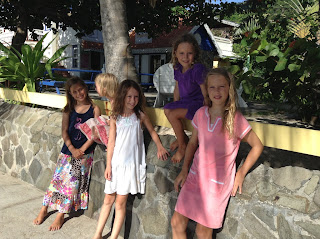In sailing parlance a "passage" is any time when you move from one place to another across open water. When you're hugging the coast and cruising from port to port you're not really passage-making. But, when you hop from one island to the next in the Leeward and Windward Islands of the Caribbean, you're crossing open water. The waves rolling your boat from one side to another, and the powerful squalls that come up periodically, are all gifts from Africa sent with love 4000 nautical miles across the open Atlantic to passage makers.
It's easy to screw up on a passage. So, sailors spend a good amount of time passage planning. The main focus is finding the right weather window when the big picture—that is, the predictable path of large weather systems—looks good. There's no predicting small, localized, but potentially powerful squalls. They just happen. Get used to it.
I've been using two main websites to do our passage planning since we left St. Martin. The first is
Ralph's Tropical Weather, run by an amateur weather buff in Florida who's been tracking hurricanes for the last 30 years. The second is
Passage Weather, which pulls together data from a wide range of sources to compile relatively real time reports and accurate forecasts of wind speeds and wave heights—the two big concerns for sailing. Passage Weather's wind info is mostly from the GFS (Global Forecast Service).
Ralph gives the big picture. Here is it before our run from Antigua to Deshaies, Guadeloupe.
Ralph basically takes a satellite image from
Intellicast and overlays his own analysis. His focus is mostly on the tropical waves from which tropical storms and hurricanes hatch that roll off the African shore and spin across the Atlantic.
The image above, from July 4, shows a tropical wave that's just passed us (3) and two more heading our way (1 & 2). The one that passed had brought slightly higher than normal winds and some rain. So, we look at this, partly, in order to time our passages between the waves.
But, also, we're looking out for hurricanes as Dafne is still within the hurricane zone and, technically speaking, this is hurricane season. As it ended up, two days later, when we arrived in Deshaies, number 2 had evolved into a numbered "invest," which is the next step from wave to storm. And, by the 8th, it had become
Tropical Storm Chantal. But more on that later.
Here is a snapshot from Passage Weather of the winds predicted for our sail to Guadeloupe.
The arrows point in the direction of the wind (mostly east, or slightly north of east), while the tails on them describe wind speed. A long tail stands for 10 knots of wind, a short for 5. Guadeloupe is the butterfly-looking island just to the lower right of center of the chart. Antigua is the round blob north-northwest of it. As you can see, for the whole trip we would be sailing in 15 knots of wind.
The colors represent trending. The darker blue that covers most of the chart represent trends between 15-20 knots. So while the wind might be mostly 15 knots, there would be times of 20 knots on the trip. For us, we LOVE 15 knots. Dafne moves nicely, and it's a comfortable ride. 20 is ok. But, we prefer 15 or so. The lighter blue patch that we would sail into halfway along represents a trending toward lighter winds, 10-15 knots. We liked that. It might take a little longer to get to our destination, but we'll stay dry and free of seasickness, and have more fun.
This chart also shows us that the winds would be coming from 60 degrees off our bow all they way, which is a bit close. 90 degrees off the bow—called a "reach"—is ideal.
In the chart below, we see wave heights, which is our second concern. Big waves = uncomfortable sailing, especially when we're sailing closer into the waves. Here's it's all about color. The darker the blue, the higher the waves. We were expecting 1-2 meter waves (3-6 feet) all the way to Guadeloupe, and mostly from the side (or, "beam"). Not bad.
And, lastly, Passage Weather also shows us precipitation, which isn't a big deal in terms of safety, though a lot of rain can reduce visibility. Precipitation often means squalls, which are very localized areas of intense wind. On this passage, in fact, we rain into two squalls, each of which packed about 25-30 knots of wind. The first only lasted 15 minutes, but the second lasted 45 minutes and brought our visibility down to less than a quarter mile. It was somewhat similar to sailing in fog in New England, and a little freaky.
Everything in sailing weather is pegged to UTC, or universal, time. UTC, also sometimes called Z or "zulu," is equivalent to Greenwich Mean Time with no daylight savings calculated. You'll see in each of these Passage Weather charts the time is 09 UTC. In the Lesser Antilles in the summer we're four hours behind UTC. We were planning a morning departure from Antigua so I looked mostly at the 5 am, or 0900 UTC, chart.
In the precipitation chart above we can see a cell of significant rain moving into Guadeloupe at our departure. I wrongly assumed that this would move quickly and clear out before we got that far—about 7 hours into our trip. But, instead we hit it and entered Deshaies in the rain.
Regardless, we had one of our best sails yet, as evidenced by the girls getting more relaxed and at home. Here they are tethered in on the trampoline between the two hulls, riding the waves as we bounce along in 18 knots of wind at nearly 8 knots of boat speed. Gotta love catamarans.


















































